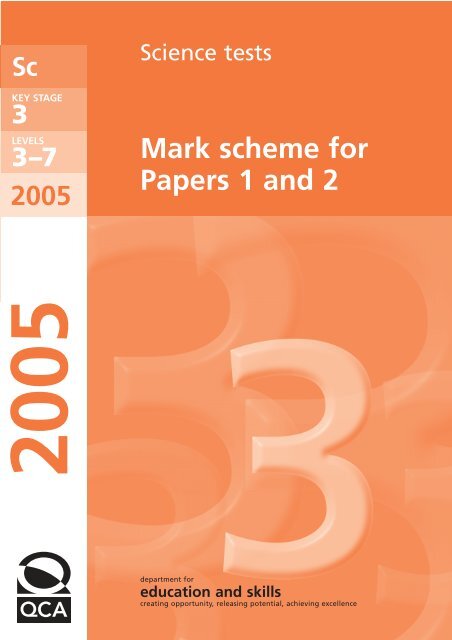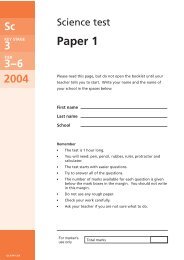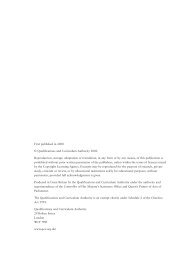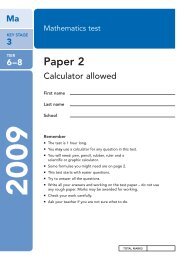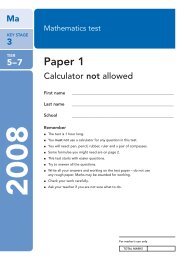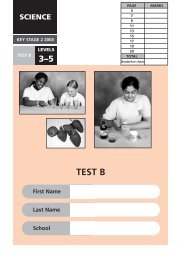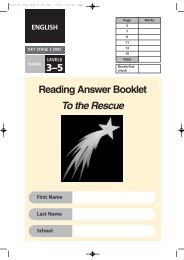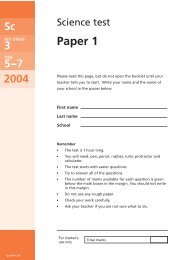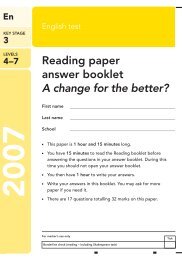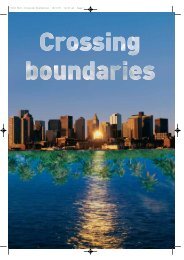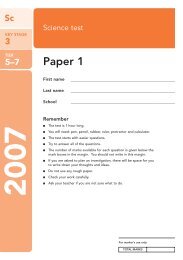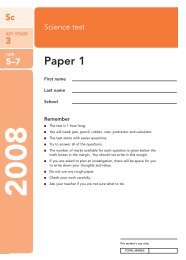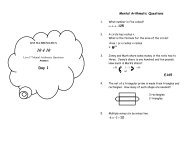Levels 3-7 - Test Papers
Levels 3-7 - Test Papers
Levels 3-7 - Test Papers
You also want an ePaper? Increase the reach of your titles
YUMPU automatically turns print PDFs into web optimized ePapers that Google loves.
Sc<br />
KEY STAGE<br />
3<br />
LEVELS<br />
3–7<br />
2005<br />
Science tests<br />
Mark scheme for<br />
<strong>Papers</strong> 1 and 2<br />
2005<br />
department for<br />
education and skills<br />
creating opportunity, releasing potential, achieving excellence
2005 KS3 Science Mark Scheme Tiers 3–6 and 5–7 Introduction<br />
Introduction<br />
The test papers will be marked by external markers. The markers will follow the mark<br />
scheme in this booklet, which is provided here to inform teachers.<br />
This booklet includes the mark scheme for paper 1 and paper 2 in both tiers.<br />
The structure of the mark scheme for tiers 3–6 and 5–7<br />
The mark scheme for each question shows:<br />
■<br />
■<br />
■<br />
■<br />
■<br />
the teaching points from the key stage 3 programme of study;<br />
the marks available for each part of the question;<br />
the total marks available for the question;<br />
the answer or answers expected, indicated by an asterisk;<br />
additional guidance to assist markers in making professional judgements.<br />
When a question appears in an identical form in both tiers, the answers to the question<br />
are given only once in the mark scheme. For clarity, both question numbers are given.<br />
The following example, from tier 3–6 paper 1 question 11 and from tier 5–7 paper 1<br />
question 3, illustrates this.<br />
Tier Q No<br />
3–6 11<br />
5–7 3<br />
Part Mark Answer Accept Additional guidance<br />
a 1<br />
2/2e<br />
any one from<br />
* the force of the muscle would<br />
be less or lost<br />
* the (fore)arm or bone would<br />
not move<br />
* the biceps or muscle could<br />
not pull on the bone<br />
* the biceps or muscle would<br />
have no effect<br />
* the biceps or muscle would<br />
have less effect<br />
accept ‘you could not bend<br />
or straighten your arm’<br />
accept ‘the biceps or muscle<br />
would not work properly’<br />
‘the arm would not work<br />
properly’ is insufficient<br />
Where more than one answer is acceptable, this is indicated in the mark scheme by<br />
‘any one from’. Each possible correct answer is marked with an asterisk. In some cases,<br />
alternative answers are indicated by ‘or’.<br />
2
2005 KS3 Science Mark Scheme Tiers 3–6 and 5–7 Introduction<br />
In the following example from part (d) of tier 5–7 paper 1 question 9, an answer<br />
giving ‘no food’ and ‘the population is poisoned’ will be awarded two marks.<br />
However an answer which gives ‘the population is poisoned’ and ‘pollution in the water’<br />
will be given only one mark, as both points are correct answers for the same mark.<br />
Part Mark Answer Accept Additional guidance<br />
d 2 any two from<br />
2/5d * new predators<br />
* no food<br />
* the population is poisoned<br />
accept ‘more predators’<br />
accept ‘not enough food’<br />
accept ‘pollution in the water’<br />
accept ‘acid rain’<br />
award marks for answers<br />
which indicate sudden,<br />
serious changes in<br />
conditions<br />
* disease<br />
* the lake or pond dried up<br />
or froze<br />
In the following example, from part (b) of tier 3–6 paper 2 question 12 and tier 5–7<br />
question 5, the statement in bold type in the Additional guidance column is given in<br />
order to indicate the general requirement of that part of the question.<br />
Part Mark Answer Accept Additional guidance<br />
b 1<br />
1/1b<br />
any one from<br />
* crushed tablets will dissolve<br />
more quickly than whole<br />
tablets<br />
* a whole tablet will take<br />
longer to dissolve<br />
* the bigger the surface or<br />
area the faster it dissolves<br />
accept ‘the finer the tablet the<br />
quicker it dissolves’<br />
accept ‘the smaller the pieces<br />
the faster it dissolves’<br />
answers must include a<br />
comparison<br />
award a mark for an answer in<br />
the past tense if a comparison<br />
is included<br />
In the Accept column there may be:<br />
■<br />
■<br />
examples of answers which are acceptable, although they do not correspond exactly<br />
to the expected answers;<br />
some examples of higher level answers, which could be given by higher attaining<br />
pupils answering questions on the lower levels in the tier.<br />
In the Additional guidance column there may be:<br />
■<br />
■<br />
■<br />
■<br />
answers which are not acceptable;<br />
a reminder, in questions involving calculations, that consequential marking may<br />
be used;<br />
instructions on action in the event of consequential marking (see below);<br />
guidance to markers where pupils have not followed the instructions on the question.<br />
3
2005 KS3 Science Mark Scheme Tiers 3–6 and 5–7 Introduction<br />
Marking<br />
The number of marks available for each part of a question and the maximum number of<br />
marks for the question as a whole are shown on the question paper. Every part of a<br />
question which has been attempted by a pupil will be marked and the mark for each part<br />
recorded in the mark box alongside that part. Half marks will not be given in any question.<br />
The total number of marks awarded for all the parts of questions on a double page will<br />
be written in the box at the bottom of the right-hand page. In some instances, this will<br />
be the sum of marks awarded for two questions. The total number of marks obtained on<br />
the paper will be recorded on the front of the test paper.<br />
The total number of marks available is 180 in tier 3–6 and 150 in tier 5–7.<br />
Using professional judgement in marking<br />
The instructions given in the mark scheme will enable the markers to decide whether<br />
pupils have correctly answered a particular question. However, there will be instances<br />
where an answer given by a pupil does not correspond to any of the possible responses<br />
shown in the mark scheme. In such cases, markers will apply their professional<br />
judgement to decide if credit should be given. They will consider whether the response:<br />
■<br />
■<br />
is equivalent to those listed;<br />
conveys the ideas underlying the question as outlined in the statement in bold type in<br />
the mark scheme, if one is given.<br />
If any doubt persists, markers will consult with their supervisors for guidance.<br />
Marking misspellings of words<br />
If a pupil misspells a word, markers will apply the following procedures:<br />
■<br />
■<br />
■<br />
if it is clear that the pupil has made a simple error, eg ‘tow’ for ‘two’ or ‘Son’ for<br />
‘Sun’, then the incorrect spelling will be accepted and the mark awarded;<br />
if a pupil misspells a word copied from the text of the question or from a selection<br />
given, and the new word does not have any inappropriate meaning, the incorrect<br />
spelling will be accepted and the mark awarded;<br />
if specific scientific vocabulary is required in the answer, a creditworthy misspelling<br />
must be a phonetic equivalent of the required word, with the major syllables of the<br />
correct word represented in the answer.<br />
Marking lists of alternative answers<br />
In some instances, pupils give more than one answer to a single question. If any of the<br />
answers given is incorrect, the mark will not be awarded, irrespective of the order in<br />
which the answers are given. In some cases, a correct answer is given alongside other<br />
answers which, while correct, would be insufficient for the mark. In these cases, the<br />
mark will be given for the correct answer.<br />
4
2005 KS3 Science Mark Scheme Tiers 3–6 and 5–7 Introduction<br />
Marking questions containing calculations<br />
Some questions require pupils to perform calculations. Where two marks are available,<br />
they are advised to show their working. Pupils who do not show their working but give<br />
the correct answer will be awarded full marks.<br />
The result of one calculation may be required in order to carry out further calculations.<br />
In such instances:<br />
■<br />
■<br />
■<br />
the term ‘consequential marking’ appears in the Additional guidance;<br />
a pupil’s result for the first calculation is treated as the starting point for the second;<br />
the pupil is awarded full credit for the second calculation if it is carried out correctly,<br />
even if the result of the first calculation was wrong.<br />
Marking answers given in the wrong place<br />
In some cases, pupils may write correct answers in the wrong part of the question.<br />
Markers will use professional judgement to decide whether a pupil has correctly<br />
understood the question and simply written the answer in the wrong place. Similarly, if<br />
pupils identify an answer by a cross or other indication when a tick is required, they will<br />
be given credit for their responses.<br />
In a planning question, if no answer is given in the expected place but the correct answer<br />
is given in the drafting box, the mark(s) will be given.<br />
Awarding levels<br />
The sum of the marks gained on both papers determines the level awarded. A copy of<br />
the level threshold tables which show the mark ranges for the award of different levels<br />
will be sent to each school by the QCA in July 2005.<br />
Schools will be notified of pupils’ results by means of a marksheet, which will be<br />
returned to schools by the External Marking Agency with the pupils’ marked scripts.<br />
The marksheet will include pupils’ scores on the test papers and the levels awarded.<br />
The 2005 key stage 3 science tests and mark schemes were developed by the<br />
University of Cambridge Local Examinations Syndicate and the Centre for Research<br />
into Primary Science and Technology (CRIPSAT) on behalf of the QCA.<br />
5
2005 KS3 Science Mark Scheme Tiers 3–6 and 5–7 Introduction<br />
Mark Allocation Grid: Tier 3–6<br />
TIER 3–6 Paper 1 TIER 3–6 Paper 2<br />
Q Sc1 Sc2 Sc3 Sc4 Q Sc1 Sc2 Sc3 Sc4<br />
1 6 1 3 4<br />
2 5 2 7<br />
3 5 3 3 2 2<br />
4 6 4 1 4<br />
5 8 5 6<br />
6 6 6 7<br />
7 1 4 7 6<br />
8 4 8 6<br />
9 5 9 4<br />
10 6 10 3 2<br />
11 5 11 2 7<br />
12 6 1 12 5<br />
13 1 4 1 13 5<br />
14 6 14 6<br />
15 6 15 5<br />
16 4 Total 25 20 22 23<br />
Total 19 33 16 22<br />
Total<br />
P1 + 2 44 53 38 45 Overall<br />
180<br />
6
2005 KS3 Science Mark Scheme Tiers 3–6 and 5–7 Introduction<br />
Mark Allocation Grid: Tier 5–7<br />
TIER 5–7 Paper 1 TIER 5–7 Paper 2<br />
Q Sc1 Sc2 Sc3 Sc4 Q Sc1 Sc2 Sc3 Sc4<br />
1 5 1 6<br />
2 6 2 4<br />
3 5 3 3 2<br />
4 6 1 4 2 7<br />
5 1 4 1 5 5<br />
6 6 6 5<br />
7 6 7 6<br />
8 4<br />
8 5<br />
9 1 4<br />
9 5<br />
10 1 4 10 5<br />
11 5 11 5<br />
12 5 12 5<br />
13 5 13 5<br />
14 5 14 5<br />
Total 13 25 15 22 Total 22 16 20 17<br />
Total<br />
P1 + 2 35 41 35 39<br />
Overall<br />
150<br />
The requirements of the Introduction to the Programme of Study apply across Sc1, Sc2, Sc3 and Sc4.<br />
The Mark Allocation Grids on this pair of pages show the context of these questions in relation to Sc1, Sc2, Sc3 and Sc4.<br />
7
2005 KS3 Science Mark Scheme Tier 3–6 Paper One<br />
Tier<br />
3–6<br />
Q No<br />
1<br />
Part Mark Answer Accept Additional guidance<br />
a i<br />
2/5c<br />
1<br />
any one from<br />
* A<br />
* B<br />
accept ‘tadpole’<br />
accept ‘trout’ or ‘fish’<br />
a ii<br />
2/4b<br />
1<br />
any one from<br />
* B<br />
* D<br />
accept ‘trout’ or ‘fish’<br />
accept ‘crocodile’ or ‘reptile’<br />
b<br />
2/4b<br />
1<br />
* backbones<br />
c<br />
2/5c<br />
1<br />
any one from<br />
* it has fins<br />
* it is streamlined<br />
accept ‘the tail helps it swim’<br />
accept a description of streamlining such as ‘it is<br />
narrow or thin’<br />
accept ‘scales make it smooth’ or ‘it is smooth’<br />
‘it has a tail’ is insufficient<br />
‘it has gills’ or ‘it has gills to breathe or to take in<br />
oxygen’ are insufficient<br />
d<br />
2/4b<br />
2<br />
*<br />
frog reptiles<br />
if all three lines are correct, award two marks<br />
if one or two lines are correct, award one mark<br />
crocodile mammals<br />
if more than one line is drawn from any animal,<br />
award no credit for that animal<br />
water vole amphibians<br />
Total 6<br />
8
2005 KS3 Science Mark Scheme Tier 3–6 Paper One<br />
Tier<br />
3–6<br />
Q No<br />
2<br />
Part Mark Answer Accept Additional guidance<br />
a i<br />
2/3a<br />
1<br />
* light<br />
accept ‘sunlight’<br />
do not accept ‘Sun’<br />
a ii<br />
2/5b<br />
1<br />
* support<br />
b<br />
2/3a<br />
1<br />
* no water ✓<br />
if more than one box is ticked, award no mark<br />
c<br />
2/3c<br />
1<br />
* minerals ✓<br />
if more than one box is ticked, award no mark<br />
d<br />
2/3d<br />
1<br />
* C ✓<br />
if more than one box is ticked, award no mark<br />
Total 5<br />
9
2005 KS3 Science Mark Scheme Tier 3–6 Paper One<br />
Tier<br />
3–6<br />
Q No<br />
3<br />
Part Mark Answer Accept Additional guidance<br />
a i<br />
2/5e<br />
1<br />
* oak tree → caterpillar → blackbird → owl<br />
all three answers are required for the mark<br />
a ii<br />
2/3a<br />
1<br />
* It makes food by photosynthesis. ✓<br />
if more than one box is ticked, award no mark<br />
b<br />
2/5d<br />
1<br />
1<br />
1<br />
1<br />
either<br />
* decreased or went down<br />
any one from<br />
* fewer leaves to feed on<br />
* gypsy moth caterpillars ate most of the<br />
leaves<br />
* less food<br />
or<br />
any one from<br />
* increased or went up<br />
* stayed the same<br />
any one from<br />
* they had enough food or leaves<br />
* more eggs hatched<br />
accept ‘gypsy moth caterpillars ate the leaves’<br />
accept ‘the gypsy moth caterpillars ate all the<br />
leaves or all the food’<br />
accept ‘no food’<br />
accept ‘they were competing for food’<br />
c<br />
2/5b<br />
1<br />
* the tree loses its leaves<br />
accept ‘no leaves’ or ‘no food’<br />
accept ‘it is too cold’<br />
accept ‘caterpillars change into pupae or<br />
chrysalises or moths’<br />
do not accept ‘caterpillars hibernate in winter’<br />
Total 5<br />
10
2005 KS3 Science Mark Scheme Tier 3–6 Paper One<br />
Tier<br />
3–6<br />
Q No<br />
4<br />
Part Mark Answer Accept Additional guidance<br />
a<br />
3/1d<br />
1<br />
1<br />
* metal<br />
any one from<br />
* heat<br />
* thermal energy<br />
b<br />
3/3a<br />
1<br />
any one from<br />
* nail<br />
* paper-clip<br />
accept ‘iron’<br />
accept ‘steel’ or ‘clip’<br />
c i<br />
3/1d<br />
1<br />
any one from<br />
* plastic<br />
* rubber<br />
* PVC<br />
accept a named plastic<br />
c ii<br />
3/1d<br />
BS/2b<br />
1<br />
any one from<br />
* to stop you getting a shock<br />
* so the wires do not touch<br />
accept ‘to stop you being electrocuted’<br />
accept ‘to make it safe’<br />
accept ‘to prevent them short circuiting’<br />
accept ‘it does not conduct electricity’<br />
‘to insulate them’ is insufficient as it is given in<br />
the question<br />
d<br />
3/1d<br />
1<br />
* iron nail and steel paper-clip ✓<br />
if more than one box is ticked, award no mark<br />
Total 6<br />
11
2005 KS3 Science Mark Scheme Tier 3–6 Paper One<br />
Tier<br />
3–6<br />
Q No<br />
5<br />
Part Mark Answer Accept Additional guidance<br />
a i<br />
1/2i<br />
1<br />
* temperature of water<br />
accept ‘temperature’<br />
do not accept ‘heat’<br />
a ii<br />
1/2i<br />
2<br />
*<br />
57 34<br />
40 74<br />
20 144<br />
award one mark for all three rows of information<br />
recorded accurately in the table<br />
award one mark for the temperature presented in<br />
ascending or descending order<br />
b<br />
1/2e<br />
2<br />
any two from<br />
* clock or timer or stopwatch<br />
* thermometer or temperature sensor<br />
* measuring cylinder<br />
* balance<br />
accept ‘beaker’<br />
accept ‘scales’<br />
‘measuring jug’ is insufficient<br />
c<br />
1/2d<br />
1<br />
* to make the test fair<br />
accept ‘as a control’<br />
d<br />
1/2k<br />
1<br />
any one from<br />
* it did not use her results<br />
* she did not describe the relationship between<br />
temperature and dissolving<br />
accept ‘it did not describe what she has found out’<br />
accept ‘she has not given the pattern in her<br />
results’<br />
accept ‘she did not say if changing the<br />
temperature affected the time’<br />
accept ‘she did not say what the result showed’<br />
‘she did not explain in detail’ is insufficient<br />
answers referring to her evaluation of her<br />
investigation or method are insufficient<br />
‘she did not say what the results were’ is<br />
insufficient<br />
12
2005 KS3 Science Mark Scheme Tier 3–6 Paper One<br />
Tier<br />
3–6<br />
Q No<br />
5<br />
Part Mark Answer Accept Additional guidance<br />
e<br />
1/2k<br />
1<br />
any one from<br />
* the hotter the water the quicker it dissolves<br />
* the higher the temperature the less time is taken<br />
for the cold cure to dissolve<br />
accept ‘the hottest dissolved quickest’<br />
accept the converse<br />
accept ‘when the water is cold it takes longer to<br />
dissolve’<br />
accept ‘when the water is hot it dissolves quickly’<br />
accept ‘temperature does affect the time to<br />
dissolve’<br />
the conclusion should refer to the independent<br />
and dependent variable<br />
Total 8<br />
13
2005 KS3 Science Mark Scheme Tier 3–6 Paper One<br />
Tier<br />
3–6<br />
Q No<br />
6<br />
Part Mark Answer Accept Additional guidance<br />
a i<br />
4/3c<br />
1<br />
*<br />
✓<br />
if more than one box is ticked, award no mark<br />
a ii<br />
4/3c<br />
1<br />
* it is reflected<br />
accept ‘it reflects’<br />
accept ‘it bounces off’<br />
b i<br />
4/1a<br />
1<br />
1<br />
1<br />
* bulb<br />
* battery or cells<br />
* switch<br />
accept ‘lamp’ or ‘light’<br />
accept ‘cell’<br />
answers must be in the correct order<br />
b ii<br />
4/1a<br />
1<br />
* a series circuit drawn with the correct symbols<br />
such as<br />
accept ‘ ’ for ‘ ’<br />
accept ‘ ’ or ‘ ’<br />
accept curved wires<br />
Total 6<br />
14
2005 KS3 Science Mark Scheme Tier 3–6 Paper One<br />
Tier<br />
3–6<br />
Q No<br />
7<br />
Part Mark Answer Accept Additional guidance<br />
a<br />
4/1d<br />
1<br />
*<br />
S<br />
both poles are required for the mark<br />
N<br />
b i<br />
4/1d<br />
1<br />
* repel<br />
b ii<br />
4/1d<br />
1<br />
* it moved upwards or returned to its original<br />
position<br />
accept ‘it would move up and down’<br />
c<br />
1/2j<br />
1<br />
* decreased<br />
accept ‘got smaller’<br />
accept ‘moved closer’<br />
d<br />
4/1d<br />
1<br />
any one from<br />
* it was attracted to the base<br />
* it moved down<br />
* it sank<br />
accept ‘the magnets are attracting’<br />
accept ‘the N and S poles attract’<br />
accept ‘it would not float’<br />
accept ‘it would stick to the base’<br />
Total 5<br />
15
2005 KS3 Science Mark Scheme Tier 3–6 Paper One<br />
Tier<br />
3–6<br />
Q No<br />
8<br />
Part Mark Answer Accept Additional guidance<br />
markers should read the answers to all parts before marking this question<br />
the draft box should be consulted for clarification of any ambiguity or omission<br />
if an answer is correct, ignore contradictory statements written in the draft box<br />
a<br />
1/2d<br />
1<br />
any suitable independent variable such as<br />
* the surface<br />
* the angle of the slope<br />
* the kind of object<br />
* the size of the push<br />
accept specific variations in objects, such as,<br />
‘weight’ or ‘mass’ or ‘surface area’ or ‘type of<br />
trainer sole’ or ‘type of shoe’<br />
b<br />
1/2d<br />
1/2e<br />
1<br />
any suitable dependent variable such as<br />
* the distance travelled<br />
* the time to move down the ramp<br />
* the force needed to start the object moving<br />
* the angle of the ramp at which the object starts<br />
moving<br />
accept ‘the time to reach a given point’<br />
accept ‘angle or height of ramp’<br />
accept ‘speed’<br />
a dependent variable (DV) without an independent<br />
variable (IV) can gain credit<br />
1<br />
any appropriate equipment to measure the<br />
dependent variable such as<br />
* ruler or metre rule<br />
* stopwatch or timer or light gates<br />
* newton meter<br />
* protractor<br />
accept ‘tape measure’<br />
accept ‘clock’<br />
do not accept a measurement strategy if a DV<br />
is not given or is incorrect<br />
c<br />
1/2d<br />
1<br />
any appropriate control variable such as<br />
* the object used<br />
* the angle of the slope<br />
* the surface used<br />
* the height of the ramp<br />
* the length of the ramp<br />
accept ‘distance travelled’<br />
only give credit for a control variable which does<br />
not conflict with the suggested investigation<br />
Total 4<br />
16
2005 KS3 Science Mark Scheme Tiers 3–6 and 5–7 Paper One<br />
Tier<br />
3–6<br />
5–7<br />
Q No<br />
9<br />
1<br />
Part Mark Answer Accept Additional guidance<br />
a i<br />
2/5f<br />
1<br />
any one from<br />
* blackbirds eat earthworms and sparrowhawks<br />
eat blackbirds<br />
* it eats blackbirds which eat earthworms<br />
* it is passed on through the food chain<br />
accept ‘from their food or from blackbirds’<br />
accept ‘it is passed on or up’<br />
a ii<br />
2/5d<br />
1<br />
any one from<br />
* they are more easily seen<br />
* brown earthworms are better camouflaged<br />
accept ‘there are more yellow earthworms’<br />
b<br />
2/5f<br />
1<br />
* the level of copper or arsenic or pollution<br />
accept ‘whether it contained arsenic or copper’<br />
accept ‘where the copper or arsenic is’<br />
c<br />
2/4b<br />
1<br />
* it has segments<br />
accept ‘its body is split into sections’<br />
award a mark for any appropriate description of<br />
segments such as ‘rings’ or ‘lines’ or ‘creases’<br />
‘they look similar’ is insufficient<br />
‘same texture’ or ‘body shape’ or ‘structure’ are<br />
insufficient<br />
d<br />
2/5b<br />
1<br />
* They feed on other living things and harm them. ✓<br />
if more than one box is ticked, award no mark<br />
Total 5<br />
17
2005 KS3 Science Mark Scheme Tiers 3–6 and 5–7 Paper One<br />
Tier<br />
3–6<br />
5–7<br />
Q No<br />
10<br />
2<br />
Part Mark Answer Accept Additional guidance<br />
a<br />
2/2i<br />
1<br />
1<br />
1<br />
*<br />
*<br />
*<br />
carbon monoxide<br />
nicotine<br />
tar<br />
causes addiction to<br />
smoking<br />
causes influenza (flu)<br />
causes lung cancer<br />
causes red blood cells to<br />
carry less oxygen<br />
if more than one line is drawn from any<br />
substance, award no mark for that substance<br />
b i<br />
2/2i<br />
1<br />
any one from<br />
* fat has been deposited<br />
* the artery has become narrower<br />
accept ‘fat’<br />
accept ‘it is blocked’<br />
b ii<br />
2/2l<br />
2<br />
any two from<br />
* less oxygen to the cells or heart muscle<br />
* less glucose to the cells or heart muscle<br />
* less blood to the cells or heart muscle<br />
accept ‘no oxygen’<br />
accept ‘no glucose’<br />
accept ‘it stops the circulation of blood’<br />
accept ‘blood cannot flow through’<br />
accept ‘it stops blood getting to the heart’<br />
do not accept ‘less air to the cells’<br />
‘nothing can get through’ is insufficient<br />
accept ‘there is a build-up of carbon dioxide’<br />
accept for two marks ‘they get less oxygenated<br />
blood’<br />
Total 6<br />
18
2005 KS3 Science Mark Scheme Tiers 3–6 and 5–7 Paper One<br />
Tier<br />
3–6<br />
5–7<br />
Q No<br />
11<br />
3<br />
Part Mark Answer Accept Additional guidance<br />
a<br />
2/2e<br />
1<br />
any one from<br />
* the force of the muscle would be less or lost<br />
* the (fore)arm or bone would not move<br />
* the biceps or muscle could not pull on the bone<br />
* the biceps or muscle would have no effect<br />
* the biceps or muscle would have less effect<br />
accept ‘you could not bend or straighten your<br />
arm’<br />
accept ‘the biceps or muscle would not work<br />
properly’<br />
‘the arm would not work properly’ is insufficient<br />
b<br />
2/2e<br />
1<br />
any one from<br />
* when one contracts the other relaxes<br />
* when the biceps contracts the forearm is raised<br />
and when the triceps contracts the forearm is<br />
lowered<br />
accept ‘one muscle moves the joint or bone or<br />
arm one way and the other muscle moves it the<br />
other way’<br />
do not accept ‘when one contracts the other<br />
expands’<br />
‘they work together’ or ‘they do opposite things’<br />
is insufficient<br />
c i<br />
2/2e<br />
c ii<br />
2/2e<br />
1<br />
1<br />
1<br />
* C<br />
* B and C ✓<br />
* D and A ✓<br />
if more than two boxes are ticked, deduct one<br />
mark for each incorrect tick<br />
minimum mark zero<br />
Total 5<br />
19
2005 KS3 Science Mark Scheme Tiers 3–6 and 5–7 Paper One<br />
Tier<br />
3–6<br />
5–7<br />
Q No<br />
12<br />
4<br />
Part Mark Answer Accept Additional guidance<br />
a<br />
3/1h<br />
1<br />
* evaporation then condensation ✓<br />
if more than one box is ticked, award no mark<br />
b<br />
3/1h<br />
1<br />
* water<br />
accept ‘distillate’<br />
c<br />
3/1a<br />
1<br />
* 100<br />
accept a temperature from 99 to 101<br />
d i<br />
4/5d<br />
1<br />
* a temperature above 15 but below 100<br />
any one from<br />
* it is heated by the water vapour<br />
* thermal energy or heat is transferred from the<br />
water vapour<br />
accept ‘vapour or steam or hot water’ for water<br />
vapour<br />
accept ‘it heats up’<br />
both the answer and the correct explanation are<br />
required for the mark<br />
d ii<br />
3/1h<br />
3/2c<br />
1<br />
1<br />
any one from<br />
* it condenses<br />
* it changes to a liquid<br />
* its temperature falls<br />
accept ‘it makes condensation’<br />
accept ‘it is liquid’<br />
accept ‘it changes state’<br />
accept ‘it turns to water’<br />
accept ‘it cools’<br />
‘it changes temperature’ is insufficient<br />
20
2005 KS3 Science Mark Scheme Tiers 3–6 and 5–7 Paper One<br />
Tier<br />
3–6<br />
5–7<br />
Q No<br />
12<br />
4<br />
Part Mark Answer Accept Additional guidance<br />
e<br />
3/1h<br />
1<br />
any one from<br />
* cold water replaces warm water<br />
* the water stays cold or cooler<br />
* there is a bigger difference in temperature<br />
between the water vapour and the water<br />
* some vapour escapes in B<br />
accept ‘it cools the water vapour better or more<br />
efficiently or quickly’<br />
accept ‘it will work faster’<br />
accept ‘it is cooled over a bigger length or for<br />
longer’<br />
accept ‘more water is collected’<br />
Total 7<br />
21
2005 KS3 Science Mark Scheme Tiers 3–6 and 5–7 Paper One<br />
Tier<br />
3–6<br />
5–7<br />
Q No<br />
13<br />
5<br />
Part Mark Answer Accept Additional guidance<br />
a i<br />
4/5a<br />
1<br />
any two from<br />
* coal<br />
* peat<br />
* natural gas<br />
* oil<br />
accept ‘gas’<br />
accept ‘petrol’ or ‘diesel’<br />
answers may be in either order<br />
both answers are required for the mark<br />
a ii<br />
3/1e<br />
1<br />
* sulphur dioxide<br />
accept ‘sulphur oxide’ or ‘sulphur trioxide’<br />
b i<br />
3/3e<br />
3/3f<br />
b ii<br />
3/3e<br />
1<br />
1<br />
* it raises the pH or it<br />
* calcium sulphate ✓<br />
accept ‘it neutralises it’ or ‘it neutralises some of<br />
the acid’<br />
if more than one box is ticked, award no mark<br />
c i<br />
2/3e<br />
1<br />
* leaves are needed for photosynthesis or for<br />
making food<br />
accept ‘they absorb light’<br />
c ii<br />
3/2i<br />
3/3g<br />
1<br />
any one from<br />
* it weathers limestone<br />
* it reacts with the stone<br />
accept ‘it erodes them or wears away the building’<br />
accept ‘it dissolves limestone or the building’<br />
‘it damages the stone’ is insufficient<br />
‘it corrodes them’ is insufficient<br />
Total 6<br />
22
2005 KS3 Science Mark Scheme Tiers 3–6 and 5–7 Paper One<br />
Tier<br />
3–6<br />
5–7<br />
Q No<br />
14<br />
6<br />
Part Mark Answer Accept Additional guidance<br />
a i<br />
4/4c<br />
1<br />
* C<br />
it is the closest to the Sun<br />
accept ‘it is closer or close’<br />
both the letter and the correct explanation are<br />
required for the mark<br />
a ii<br />
4/4c<br />
1<br />
* an arrow from each of the points A, B, C and D<br />
towards the Sun<br />
all four arrows are required for the mark<br />
a iii<br />
4/4c<br />
1<br />
* A<br />
it is furthest from the Sun or the effect of the<br />
Sun’s gravity is weakest<br />
accept ‘it is further or far away’<br />
accept ‘gravity is low or lower’<br />
both the letter and the correct explanation are<br />
required for the mark<br />
b i<br />
1/2j<br />
4/4b<br />
1<br />
* a number greater than 2870 and smaller than<br />
5900<br />
b ii<br />
1/2j<br />
4/4b<br />
1<br />
* the further away the lower the temperature<br />
accept the converse<br />
accept ‘the further away the colder it is’<br />
b iii<br />
4/5g<br />
1<br />
any one from<br />
* planets further away receive less energy or<br />
heat<br />
* energy from the Sun spreads out<br />
* less heat reaches the planets that are further<br />
away<br />
accept ‘light’ for energy<br />
accept ‘the Sun’s rays are weaker or not as<br />
strong’<br />
do not accept ‘the Sun’s heat cannot reach<br />
planets that are far away’<br />
‘the Sun is weaker’ is insufficient<br />
Total 6<br />
23
2005 KS3 Science Mark Scheme Tiers 3–6 and 5–7 Paper One<br />
Tier<br />
3–6<br />
5–7<br />
Q No<br />
15<br />
7<br />
Part Mark Answer Accept Additional guidance<br />
a i<br />
1/2d<br />
1<br />
* the number of turns or coils of wire<br />
accept ‘the coils’<br />
accept ‘the turns’<br />
a ii<br />
1/2d<br />
1<br />
any one from<br />
* the current<br />
* the length or thickness or material of the wire<br />
or coil<br />
* the circumference of the coil<br />
* the size of paper-clips<br />
accept ‘the voltage or power’<br />
accept ‘the wire’<br />
accept ‘the paper-clips’<br />
accept ‘position of the coil on the nail’<br />
accept ‘tightness of the coil’<br />
accept ‘distance between turns’<br />
accept ‘the nail’<br />
do not accept ‘the number of paper-clips’<br />
a iii<br />
1/2e<br />
1<br />
any one from<br />
* count the paper-clips picked up<br />
* measure their mass<br />
accept ‘number of paper-clips’<br />
accept ‘count them’<br />
accept ‘weigh them’<br />
accept ‘the more clips the stronger the magnet’<br />
accept ‘measure the distance at which a magnet<br />
will just pick up a paper-clip’<br />
b<br />
1/2n<br />
1<br />
any one from<br />
* an inaccuracy in results<br />
* a problem with the data or results<br />
* a problem with the method<br />
accept a description of inaccuracies, such as<br />
‘she counted the number of clips wrongly’<br />
accept ‘something wrong with the tests’<br />
accept ‘she used different sized paper-clips’<br />
accept ‘the paper-clips were already magnetised’<br />
accept ‘she did something wrong’<br />
‘the test is unfair’ is insufficient<br />
24
2005 KS3 Science Mark Scheme Tiers 3–6 and 5–7 Paper One<br />
Tier<br />
3–6<br />
5–7<br />
Q No<br />
15<br />
7<br />
Part Mark Answer Accept Additional guidance<br />
c i<br />
1/2g<br />
1<br />
*<br />
✓<br />
if more than one box is ticked, award no mark<br />
c ii<br />
1/2e<br />
1<br />
any one from<br />
* with bigger paper-clips she might miss the<br />
precise point at which the electromagnet<br />
stopped picking up paper-clips<br />
* the smaller paper-clips might help to identify the<br />
precise point at which the electromagnet<br />
stopped picking up paper-clips<br />
accept ‘she would pick up differences between<br />
the number of turns of the coil’<br />
accept ‘she might not see a change with big<br />
paper-clips or she would see a change with<br />
smaller paper-clips’<br />
accept ‘it is more precise or more sensitive’<br />
‘it will pick up a few large paper-clips but a lot of<br />
small paper-clips’ is insufficient<br />
award a mark for a response identifying that<br />
greater precision is possible with smaller<br />
increments<br />
‘they are smaller’ is insufficient<br />
Total 6<br />
25
2005 KS3 Science Mark Scheme Tiers 3–6 and 5–7 Paper One<br />
Tier<br />
3–6<br />
5–7<br />
Q No<br />
16<br />
8<br />
Part Mark Answer Accept Additional guidance<br />
a<br />
4/2c<br />
1<br />
* A<br />
b<br />
4/2c<br />
1<br />
any one from<br />
* he will remain stationary<br />
* he will continue moving at a constant speed<br />
accept ‘he floats’<br />
accept ‘nothing’<br />
1<br />
any one from<br />
* there is no net force<br />
* the pairs of forces are equal<br />
accept ‘all the forces cancel out’<br />
accept ‘they cancel each other out’<br />
accept ‘the forces are balanced’<br />
‘the forces are equal’ is insufficient<br />
c<br />
4/2c<br />
1<br />
*<br />
accept any arrow drawn going up and to the right<br />
Total 4<br />
26
2005 KS3 Science Mark Scheme Tier 5–7 Paper One<br />
Tier<br />
5–7<br />
Q No<br />
9<br />
Part Mark Answer Accept Additional guidance<br />
a<br />
1/2j<br />
1<br />
* B<br />
the graph increases most steeply<br />
accept ‘the graph is steepest’<br />
accept ‘the line is steeper’<br />
accept ‘it is very steep’<br />
both the answer and the correct explanation are<br />
required for the mark<br />
b<br />
1/2j<br />
2/5d<br />
1<br />
* C<br />
any one from<br />
* the slope of the graph becomes less steep<br />
* the growth of the population slows down<br />
accept ‘the population begins to level off’<br />
both the answer and the correct explanation are<br />
required for the mark<br />
do not accept ‘they stop having offspring’ or ‘they<br />
stop multiplying’<br />
c<br />
1/2j<br />
2/5d<br />
1<br />
* they are equal or the same<br />
any one from<br />
* the graph is horizontal<br />
* the population does not change<br />
accept ‘the graph is flat’<br />
both the answer and the correct explanation are<br />
required for the mark<br />
‘they are steady’ is insufficient<br />
‘the line is straight’ is insufficient<br />
d<br />
2/5d<br />
2<br />
any two from<br />
* new predators<br />
* no food<br />
* the population is poisoned<br />
* disease<br />
* the lake or pond dried up or froze<br />
accept ‘more predators’<br />
accept ‘not enough food’<br />
accept ‘pollution in the water’<br />
accept ‘acid rain’<br />
award marks for answers which indicate<br />
sudden, serious changes in conditions<br />
Total 5<br />
27
2005 KS3 Science Mark Scheme Tier 5–7 Paper One<br />
Tier<br />
5–7<br />
Q No<br />
10<br />
Part Mark Answer Accept Additional guidance<br />
a<br />
1/2e<br />
1<br />
any one from<br />
* it is the temperature of the human body or the<br />
stomach<br />
* the enzyme or pepsin works best at that<br />
temperature<br />
b<br />
2/2b<br />
1<br />
* there was a larger surface for the enzyme to act<br />
on<br />
accept ‘the enzyme came into contact with more<br />
of the gelatin’<br />
accept ‘the surface or area was bigger’<br />
‘because the gelatin had been chopped up’ is<br />
insufficient<br />
c 1 * it or the enzyme was destroyed or denatured<br />
do not accept ‘the enzyme was killed’<br />
d i<br />
2/2b<br />
d ii<br />
2/2c<br />
1<br />
1<br />
* amino acids ✓<br />
any one from<br />
* proteins cannot be absorbed<br />
* proteins are too big to pass through the lining of<br />
the intestine or blood vessels<br />
* amino acids can be absorbed<br />
* amino acids can pass through the wall of the<br />
intestine or blood vessels<br />
* amino acids are small enough to be absorbed<br />
* to make them soluble<br />
accept ‘so proteins or they can be absorbed’<br />
if more than one box is ticked, award no mark<br />
‘they need to be digested or broken down’ is<br />
insufficient<br />
Total 5<br />
28
2005 KS3 Science Mark Scheme Tier 5–7 Paper One<br />
Tier<br />
5–7<br />
Q No<br />
11<br />
Part Mark Answer Accept Additional guidance<br />
a i<br />
3/1g<br />
a ii<br />
3/1e<br />
1<br />
1<br />
* B<br />
* D<br />
b i<br />
3/1e<br />
1<br />
any one from<br />
* a compound or a new substance has been<br />
formed<br />
accept ‘the ratio is always 1P to 2Qs’<br />
accept ‘the atoms or particles have joined’<br />
* R or the product is a new substance<br />
accept ‘the elements have joined’<br />
b ii<br />
3/1e<br />
1<br />
* substance Q: oxygen<br />
* substance R: carbon dioxide<br />
both answers are required for the mark<br />
b iii<br />
3/2g<br />
1<br />
* the same numbers of each type of atom are<br />
present<br />
accept ‘the same number of atoms is present’<br />
accept ‘the same particles or same number of<br />
particles are present’<br />
accept ‘there is the same amount of each<br />
element’<br />
do not accept ‘the same number of molecules is<br />
there’<br />
‘the same amount of elements’ is insufficient<br />
Total 5<br />
29
2005 KS3 Science Mark Scheme Tier 5–7 Paper One<br />
Tier<br />
5–7<br />
Q No<br />
12<br />
Part Mark Answer Accept Additional guidance<br />
a<br />
1/2a<br />
1/2d<br />
1<br />
1<br />
* the metal<br />
any one from<br />
* the change in the mass of the contents of the<br />
crucible after burning<br />
* the change in the mass of the crucible and its<br />
contents after burning<br />
accept ‘whether the mass of metal increases or<br />
decreases or stays the same’<br />
accept ‘weight before and after burning’<br />
1/2e<br />
1<br />
* make sure all the product is weighed<br />
accept ‘keep a lid on the crucible’<br />
accept ‘starting mass of metal’<br />
accept ‘mass of the metal’<br />
accept ‘the same crucible’<br />
accept ‘enough time for the reaction to occur’<br />
accept ‘sufficient heat for burning to occur’<br />
accept ‘burn the metals for the same length of<br />
time’<br />
award a mark for any suitable rigour in the<br />
procedure or identification of any control variable<br />
‘the atmosphere it is heated in’ is insufficient<br />
1/1c<br />
1<br />
* an increase in the mass following burning for all<br />
three metals<br />
accept ‘mass will increase’<br />
accept ‘weight increase’<br />
b<br />
1/2i<br />
1<br />
* any appropriate table in which the results can<br />
be recorded such as<br />
metal<br />
gain or loss or change<br />
in mass<br />
accept a table in which the rows rather than the<br />
columns are labelled<br />
accept ‘weight’ for mass<br />
accept<br />
change in mass<br />
units are not required in the table<br />
ignore incorrect units<br />
or<br />
metal 1<br />
metal<br />
mass at mass after<br />
the start burning<br />
metal 2<br />
metal 3<br />
Total 5<br />
30
2005 KS3 Science Mark Scheme Tier 5–7 Paper One<br />
Tier<br />
5–7<br />
Q No<br />
13<br />
Part Mark Answer Accept Additional guidance<br />
a i<br />
4/3i<br />
1<br />
* Paul<br />
James<br />
Sylvia<br />
accept ‘light’<br />
accept ‘vibration’<br />
accept ‘sound’<br />
answers must be in the correct order<br />
all three answers in the correct order are<br />
required for the mark<br />
a ii<br />
4/2a<br />
1<br />
* 3<br />
accept 1020<br />
accept ‘ ’<br />
accept ‘ 340<br />
b i<br />
4/3j<br />
1<br />
* the energy or the sound is more spread out<br />
accept ‘some of the sound is absorbed by the air’<br />
accept ‘the amplitude decreases’<br />
‘vibrations decrease’ is insufficient<br />
b ii<br />
4/3k<br />
2<br />
*<br />
award one mark for a wave with a smaller<br />
amplitude<br />
award one mark for a wave with the same<br />
frequency<br />
award the marks for a wave with the correct<br />
amplitude and frequency but which is not centred<br />
on the middle line of the grid or which is not in<br />
phase with the drawn wave<br />
the marks may be awarded for a wave drawn on<br />
Sylvia’s grid<br />
Total 5<br />
31
2005 KS3 Science Mark Scheme Tier 5–7 Paper One<br />
Tier<br />
5–7<br />
Q No<br />
14<br />
Part Mark Answer Accept Additional guidance<br />
a i<br />
4/2f<br />
1<br />
1<br />
* 2<br />
* Ncm<br />
accept ‘0.2 × 10’<br />
accept ‘cmN’<br />
accept ‘0.02 Nm’ for both marks<br />
a ii<br />
4/2f<br />
1<br />
* 2 (Ncm)<br />
accept ‘0.02 Nm’<br />
accept ‘the same’<br />
accept the numerical answer to a i<br />
unit not required<br />
the mark for the unit may be awarded here if not<br />
given in part a i<br />
consequential marking applies<br />
a iii<br />
4/2f<br />
1<br />
* 0.1<br />
accept the numerical answer to a ii ÷ 20<br />
accept the numerical answer to a i ÷ 20 if a ii<br />
has been omitted or if the answer given to a ii is<br />
‘the same’<br />
consequential marking applies<br />
b 1 * 0.3<br />
accept the answer to a iii + 0.2<br />
consequential marking applies<br />
Total 5<br />
32
2005 KS3 Science Mark Scheme Tier 3–6 Paper Two<br />
Tier<br />
3–6<br />
Q No<br />
1<br />
Part Mark Answer Accept Additional guidance<br />
a i<br />
4/4b<br />
a ii<br />
4/4b<br />
a iii<br />
4/4b<br />
a iv<br />
4/4b<br />
1<br />
1<br />
1<br />
1<br />
* A<br />
* D<br />
* E<br />
* G<br />
accept ‘Jupiter’<br />
b i<br />
1/2i<br />
1<br />
* a bar drawn to 12 N/kg<br />
the top of the bar must be in the middle third<br />
between 10 and 15<br />
b ii<br />
1/2k<br />
1<br />
any one from<br />
* Jupiter<br />
* Saturn<br />
* Neptune<br />
b iii<br />
1/2k<br />
1<br />
* Jupiter<br />
Total 7<br />
33
2005 KS3 Science Mark Scheme Tier 3–6 Paper Two<br />
Tier<br />
3–6<br />
Q No<br />
2<br />
Part Mark Answer Accept Additional guidance<br />
a<br />
4/2b<br />
4/2c<br />
4/2d<br />
1<br />
*<br />
the weight of the<br />
buggy<br />
A<br />
if more than one line is drawn from any one force<br />
award no mark for that force<br />
1<br />
1<br />
*<br />
*<br />
the force pulling the<br />
buggy along<br />
the friction between<br />
the skis and the snow<br />
B<br />
C<br />
D<br />
b<br />
4/2a<br />
1<br />
* 800<br />
accept ‘80 x 10’<br />
c<br />
4/2g<br />
1<br />
any one from<br />
* it weighed more<br />
* the mass was greater<br />
* it weighed less at the end<br />
accept ‘it was heavier’<br />
accept ‘it only weighed 130 at the end’<br />
accept ‘there was more food or fuel or supplies’<br />
accept ‘more pressure’<br />
34
2005 KS3 Science Mark Scheme Tier 3–6 Paper Two<br />
Tier<br />
3–6<br />
Q No<br />
2<br />
Part Mark Answer Accept Additional guidance<br />
d<br />
4/2g<br />
1<br />
any one from<br />
* they spread out the weight<br />
* they have a bigger surface or area<br />
* they can slide easily<br />
accept ‘they do not sink into the snow’<br />
accept ‘wheels sink’<br />
accept ‘they reduce the pressure’<br />
accept ‘less friction’<br />
‘they are bigger’ is insufficient<br />
‘it can slide’ is insufficient<br />
e<br />
4/2c<br />
1<br />
any one from<br />
* there is a bigger surface or area<br />
* there is a bigger force<br />
* it catches more air or wind<br />
do not accept ‘there is more air resistance’<br />
Total 7<br />
35
2005 KS3 Science Mark Scheme Tier 3–6 Paper Two<br />
Tier<br />
3–6<br />
Q No<br />
3<br />
Part Mark Answer Accept Additional guidance<br />
a i<br />
1/2k<br />
a ii<br />
2/2n<br />
a iii<br />
1/2e<br />
BS/2b<br />
1<br />
1<br />
1<br />
* 35<br />
* 37°C ✓<br />
any one from<br />
* less chance of micro-organisms being passed<br />
on or spread<br />
* glass could break<br />
* mercury or alcohol or liquid could spill (if the<br />
glass thermometer broke)<br />
* mercury is poisonous<br />
* you could choke<br />
accept ‘less chance of germs being passed on’<br />
accept ‘might pass on disease’<br />
accept ‘a child might bite or swallow the<br />
thermometer’<br />
if more than one box is ticked, award no mark<br />
b<br />
2/2n<br />
1<br />
any one from<br />
* bacteria<br />
* fungi<br />
* protozoa<br />
accept a named non-viral pathogenic<br />
micro-organism such as ‘salmonella’<br />
do not accept names of diseases<br />
do not accept ‘germs’<br />
c i<br />
1/2f<br />
1<br />
any one from<br />
* so that alcohol can be seen<br />
* alcohol is difficult to see<br />
* you cannot easily see a colourless liquid<br />
* to make it easier to read the thermometer<br />
accept ‘so you can see it’<br />
accept ‘you cannot see a colourless liquid’<br />
accept ‘so you can read it’<br />
c ii<br />
3/1a<br />
3/2c<br />
1<br />
1<br />
* gas<br />
* liquid<br />
answers must be in the correct order<br />
Total 7<br />
36
2005 KS3 Science Mark Scheme Tier 3–6 Paper Two<br />
Tier<br />
3–6<br />
Q No<br />
4<br />
Part Mark Answer Accept Additional guidance<br />
a i<br />
3/3d<br />
1<br />
any one from<br />
* lemonade<br />
* fruit juice<br />
accept ‘fruit or juice’<br />
a ii<br />
3/3d<br />
1<br />
any one from<br />
* milk<br />
* water<br />
b i<br />
3/3d<br />
1<br />
any one from<br />
* blue<br />
* dark blue<br />
* purple<br />
b ii<br />
1/2k<br />
1<br />
any one from<br />
* it bubbled<br />
* bubbles were formed<br />
accept ‘it fizzed’<br />
accept ‘bubbles’<br />
accept ‘effervescence’<br />
c<br />
3/3e<br />
1<br />
* neutralisation ✓<br />
if more than one box is ticked, award no mark<br />
Total 5<br />
37
2005 KS3 Science Mark Scheme Tier 3–6 Paper Two<br />
Tier<br />
3–6<br />
Q No<br />
5<br />
Part Mark Answer Accept Additional guidance<br />
a i<br />
3/2b<br />
1<br />
* the water or it went blue<br />
accept ‘it changed colour’<br />
accept ‘it got darker’<br />
accept ‘there were fewer crystals’<br />
accept ‘some of the crystals or copper sulphate<br />
disappeared’<br />
a ii<br />
3/2b<br />
1<br />
any one from<br />
* stir it<br />
* heat it<br />
* use hotter water<br />
* grind up or crush the crystals<br />
accept ‘use warm water’<br />
b<br />
3/2c<br />
1<br />
any one from<br />
* crystals<br />
* copper sulphate<br />
accept ‘solid’<br />
c i<br />
1/2k<br />
3/2b<br />
c ii<br />
1/2k<br />
3/2b<br />
c iii<br />
1/2j<br />
3/2b<br />
1<br />
1<br />
1<br />
* 10<br />
* Q<br />
* P and Q<br />
answers may be in either order<br />
both answers are required for the mark<br />
Total 6<br />
38
2005 KS3 Science Mark Scheme Tier 3–6 Paper Two<br />
Tier<br />
3–6<br />
Q No<br />
6<br />
Part Mark Answer Accept Additional guidance<br />
a i<br />
2/2b<br />
a ii<br />
2/2b<br />
a iii<br />
2/2c<br />
1<br />
1<br />
1<br />
* D<br />
* E<br />
any one from<br />
* blood<br />
* blood vessels<br />
accept ‘plasma’<br />
accept a named blood vessel<br />
accept ‘arteries’<br />
accept ‘veins’<br />
a mark should be awarded for ‘red or white<br />
blood cells’ as knowledge of the function of blood<br />
cells is not expected at this level<br />
the mark is awarded for the reference to blood<br />
b<br />
2/2d<br />
1<br />
* to provide energy ✓<br />
if more than one box is ticked, award no mark<br />
c i<br />
2/2a<br />
c ii<br />
2/2a<br />
1<br />
1<br />
* Clare<br />
* Nadia<br />
accept ‘lemonade and jam or doughnut’<br />
accept ‘cheeseburger and chips’ or ‘burger and<br />
chips’<br />
c iii<br />
2/2a<br />
1<br />
any one from<br />
* it causes heart disease<br />
* it could give you a heart attack<br />
* it clogs your arteries or blood vessels<br />
accept ‘it is bad for your heart’<br />
accept ‘it might give you a stroke’<br />
accept ‘it makes you fat’<br />
accept ‘it is bad for the liver’<br />
Total 7<br />
39
2005 KS3 Science Mark Scheme Tier 3–6 Paper Two<br />
Tier<br />
3–6<br />
Q No<br />
7<br />
Part Mark Answer Accept Additional guidance<br />
a<br />
1/2k<br />
1<br />
* a male has antlers<br />
accept ‘the males have horns’<br />
accept ‘it was bigger than others’<br />
accept ‘it has a beard or hair around the neck’<br />
b<br />
1/2o<br />
1<br />
* they all have these characteristics<br />
accept ‘all deer have these things’<br />
accept ‘all young deer look the same’<br />
accept ‘they all have spots or skinny legs’<br />
accept ‘an adult fallow deer has spots’<br />
‘an adult female has spots’ is insufficient<br />
c<br />
1/2k<br />
2<br />
any two from<br />
* (adult) red deer does not have spots<br />
* the shape of the antlers or horns<br />
* the red deer has hair round its neck<br />
accept the converse<br />
accept ‘the spots’<br />
accept ‘the things on its head are too wide’<br />
accept ‘the red deer is hairy’<br />
‘it looks like a fallow deer’ or ‘it is a fallow deer’<br />
are insufficient<br />
d<br />
1/2k<br />
2<br />
any two from<br />
* beard or hair under neck<br />
* the shape of the antlers<br />
* rounder nose<br />
accept ‘too hairy’<br />
accept ‘different kind of fur’<br />
accept ‘the shape of the horns’<br />
accept ‘horns’<br />
accept ‘it has more than two antlers’<br />
accept ‘the head or face is a different shape or<br />
size’<br />
accept ‘the face looks different’<br />
accept ‘bigger feet’ or ‘different hooves’<br />
do not accept ‘it has a hump’<br />
Total 6<br />
40
2005 KS3 Science Mark Scheme Tiers 3–6 and 5–7 Paper Two<br />
Tier<br />
3–6<br />
5–7<br />
Q No<br />
8<br />
1<br />
Part Mark Answer Accept Additional guidance<br />
a i<br />
4/5e<br />
a ii<br />
4/5e<br />
a iii<br />
4/5e<br />
1<br />
1<br />
1<br />
1<br />
* electrical<br />
* kinetic<br />
* gravitational potential<br />
* kinetic or sound or thermal<br />
accept ‘movement’<br />
accept ‘gravitational’ or ‘potential’<br />
accept ‘heat’ for thermal<br />
answers must be in the correct order<br />
accept for two marks ‘kinetic into sound’ or<br />
‘kinetic into thermal’<br />
b<br />
4/5a<br />
1<br />
advantage<br />
* the energy will always be replaced<br />
* it is renewable<br />
* it is free to run<br />
* a battery might leak<br />
accept ‘it will not run out’<br />
accept ‘it does not use fuel or mains electricity’<br />
accept ‘it is cheap’<br />
accept ‘no pollution with a solar cell’<br />
do not accept ‘can be used again’<br />
1<br />
disadvantage<br />
* if the Sun goes in the pump will stop<br />
* it will not work at night or in the dark<br />
accept ‘it must be in the Sun to work’<br />
accept ‘it is not sunny all the time’<br />
Total 6<br />
41
2005 KS3 Science Mark Scheme Tiers 3–6 and 5–7 Paper Two<br />
Tiers<br />
3–6<br />
5–7<br />
Q No<br />
9<br />
2<br />
Part Mark Answer Accept Additional guidance<br />
a<br />
4/1a<br />
4/1b<br />
A B C D<br />
off off off off<br />
award a mark for each correct row<br />
1<br />
*<br />
off off off off<br />
1<br />
*<br />
on on on on<br />
1<br />
*<br />
on on off off<br />
b<br />
4/1a<br />
4/1b<br />
1<br />
any one from<br />
* close S4 and S5<br />
* only leave S3 open<br />
accept ‘close 4 and 5’<br />
accept ‘only leave 3 open’<br />
‘leave switch 3 or 3 open’ is insufficient<br />
Total 4<br />
42
2005 KS3 Science Mark Scheme Tiers 3–6 and 5–7 Paper Two<br />
Tiers<br />
3–6<br />
5–7<br />
Q No<br />
10<br />
3<br />
Part Mark Answer Accept Additional guidance<br />
a i<br />
3/1b<br />
1<br />
* five circles not touching and randomly arranged<br />
accept at least three circles<br />
accept pairs of similar atoms<br />
a ii<br />
3/1b<br />
1<br />
* they are closer<br />
do not accept ‘they are close’<br />
do not accept ‘they move faster’<br />
b<br />
3/1b<br />
1<br />
* greater than<br />
accept ‘greater’<br />
c i<br />
4/3j<br />
1<br />
* the amplitude gets smaller<br />
accept ‘the height of the waves gets less’<br />
accept ‘the waves get shorter or smaller’<br />
c ii<br />
4/3k<br />
1<br />
any one from<br />
* the peaks or troughs are equally spaced<br />
* the frequency is constant or does not change<br />
accept ‘the waves are the same distance apart’<br />
accept ‘there are four peaks or waves or troughs<br />
between the lines’<br />
accept ‘the width of each wave is the same’<br />
accept ‘the lines are equally spaced’<br />
accept ‘the wavelength is the same’<br />
do not accept ‘it vibrates less’<br />
Total 5<br />
43
2005 KS3 Science Mark Scheme Tiers 3–6 and 5–7 Paper Two<br />
Tiers<br />
3–6<br />
5–7<br />
Q No<br />
11<br />
4<br />
Part Mark Answer Accept Additional guidance<br />
a<br />
3/3d<br />
2<br />
*<br />
liquid acidic neutral alkaline<br />
alcohol ✔<br />
dilute hydrochloric ✔<br />
acid<br />
distilled water ✔<br />
award one mark for a correct tick for both<br />
alcohol and distilled water<br />
award one mark for a correct tick for both<br />
vinegar and sodium hydroxide solution<br />
if more than one column is ticked for any liquid<br />
award no mark for the corresponding pair of<br />
liquids<br />
vinegar ✔<br />
sodium hydroxide<br />
solution<br />
✔<br />
b i<br />
1/2f<br />
1<br />
any one from<br />
* to clean the probe or it<br />
* to prevent contamination<br />
* to get an accurate reading<br />
* so the liquids do not get mixed up<br />
* it is neutral<br />
accept ‘to neutralise the probe’ or ‘so that it does<br />
not affect the other liquids’ or ‘to make it pH 7’<br />
‘to make it a fair test’ is insufficient<br />
b ii<br />
3/3d<br />
1<br />
* alcohol<br />
accept ‘the first or top one’<br />
44
2005 KS3 Science Mark Scheme Tiers 3–6 and 5–7 Paper Two<br />
Tiers<br />
3–6<br />
5–7<br />
Q No<br />
11<br />
4<br />
Part Mark Answer Accept Additional guidance<br />
c i<br />
3/3d<br />
1<br />
* hydrochloric acid has a lower pH or is more<br />
acidic<br />
accept the converse<br />
accept ‘vinegar is a weaker acid’<br />
‘vinegar is a weak acid’ is insufficient<br />
c ii<br />
1/2k<br />
1<br />
any one from<br />
* more bubbles would be given off<br />
* bubbles would be given off more rapidly<br />
* there would be a bigger rise in temperature<br />
* the magnesium would be used up more quickly<br />
accept ‘more bubbles’ or ‘more fizzing’<br />
accept ‘there would be a rise in temperature’ or<br />
‘the test-tube would get hot’<br />
d i<br />
3/1f<br />
3/3e<br />
1<br />
1<br />
* magnesium chloride +<br />
* hydrogen<br />
answers may be in either order<br />
d ii<br />
3/3e<br />
1<br />
any one from<br />
* the acid was used up<br />
* the magnesium was used up<br />
accept ‘there were no reactants left’<br />
accept ‘one of the reactants has been used up’<br />
accept ‘the reaction was complete’<br />
do not accept ‘the magnesium had dissolved’<br />
Total 9<br />
45
2005 KS3 Science Mark Scheme Tiers 3–6 and 5–7 Paper Two<br />
Tiers<br />
3–6<br />
5–7<br />
Q No<br />
12<br />
5<br />
Part Mark Answer Accept Additional guidance<br />
a<br />
1/2d<br />
1<br />
any one from<br />
* size of pieces of tablet<br />
* surface area of the tablet<br />
accept ‘size of tablet’<br />
accept ‘whether the tablet is whole or crushed’<br />
accept ‘form of the tablet’<br />
accept ‘particle size’<br />
accept ‘mass of each piece’<br />
accept ‘number of pieces’<br />
do not accept ‘mass of tablet’<br />
b<br />
1/1b<br />
1<br />
any one from<br />
* crushed tablets will dissolve more quickly than<br />
whole tablets<br />
* a whole tablet will take longer to dissolve<br />
* the bigger the surface or area the faster it<br />
dissolves<br />
accept ‘the finer the tablet the quicker it<br />
dissolves’<br />
accept ‘the smaller the pieces the faster it<br />
dissolves’<br />
answers must include a comparison<br />
award a mark for an answer in the past tense if a<br />
comparison is included<br />
c<br />
1/2d<br />
1<br />
* temperature of the water<br />
accept ‘temperature’<br />
d<br />
1/2j<br />
1<br />
any one from<br />
* the higher the temperature the quicker the<br />
tablet dissolves<br />
* the lower the temperature the longer it takes to<br />
dissolve<br />
answers must include a comparison<br />
‘at the lowest temperature it takes a long time to<br />
dissolve’ is insufficient<br />
‘at the highest temperature it dissolves quickly’ is<br />
insufficient<br />
e<br />
1/2j<br />
1<br />
* 40<br />
accept a temperature from 38 to 44<br />
Total 5<br />
46
2005 KS3 Science Mark Scheme Tiers 3–6 and 5–7 Paper Two<br />
Tiers<br />
3–6<br />
5–7<br />
Q No<br />
13<br />
6<br />
Part Mark Answer Accept Additional guidance<br />
a<br />
2/2g<br />
1<br />
* oviduct ✔<br />
if more than one box is ticked, award no mark<br />
b<br />
2/2g<br />
1<br />
any one from<br />
* some eggs or sperm might be eaten or lost<br />
* eggs or sperm are not protected inside the<br />
body<br />
* to increase the chance of an egg being<br />
fertilised<br />
* some eggs might not be fertilised<br />
* some are washed away<br />
* some of the offspring might be eaten<br />
accept ‘to make fertilisation more likely’<br />
accept ‘some die’<br />
accept ‘more tadpoles’<br />
c i<br />
2/2j<br />
1<br />
any one from<br />
* to let oxygen or air into the egg<br />
* to let carbon dioxide or waste gases out<br />
* to allow gas exchange<br />
accept ‘for respiration’<br />
do not accept ‘to let waste out’<br />
c ii<br />
2/5c<br />
1<br />
any one from<br />
* for protection<br />
* to stop the egg drying out<br />
* it stops infection or disease<br />
accept ‘it stops it drying out’<br />
accept ‘it stops micro-organisms or bacteria or<br />
viruses or germs getting in’<br />
accept ‘to retain the contents’<br />
‘it stops infection getting in’ is insufficient<br />
d<br />
2/2h<br />
1<br />
any one from<br />
* food passes from the mother to the embryo or<br />
baby<br />
* the embryo is fed through the placenta<br />
* it gets food from the mother’s blood<br />
accept ‘the mother provides food’<br />
accept ‘it is fed through the umbilical cord’<br />
do not accept ‘it gets food from the blood’<br />
Total 5<br />
47
2005 KS3 Science Mark Scheme Tiers 3–6 and 5–7 Paper Two<br />
Tiers<br />
3–6<br />
5–7<br />
Q No<br />
14<br />
7<br />
Part Mark Answer Accept Additional guidance<br />
a i<br />
2/1b<br />
1<br />
1<br />
* name: nucleus<br />
* function: it controls the cell<br />
accept ‘nuclei’<br />
accept ‘it contains genetic information’<br />
accept ‘contains chromosomes’<br />
‘it is the brain of the cell’ is insufficient<br />
a ii<br />
2/1a<br />
1<br />
* tissue ✔<br />
if more than one box is ticked, award no mark<br />
b i<br />
2/2c<br />
1<br />
any one from<br />
* to push food or waste along<br />
* to break up large pieces of food<br />
* to churn food<br />
accept ‘for peristalsis’<br />
accept ‘mechanical digestion’<br />
accept ‘to mix in enzymes’<br />
‘to digest food’ is insufficient<br />
b ii<br />
2/2b<br />
1<br />
* they speed up digestion<br />
accept ‘they digest them’<br />
accept ‘they break them down’<br />
accept ‘they turn it into amino acids’<br />
b iii<br />
2/2a<br />
1<br />
* fibre ✔<br />
if more than one box is ticked, award no mark<br />
Total 6<br />
48
2005 KS3 Science Mark Scheme Tiers 3–6 and 5–7 Paper Two<br />
Tiers<br />
3–6<br />
5–7<br />
Q No<br />
15<br />
8<br />
Part Mark Answer Accept Additional guidance<br />
a<br />
1/2e<br />
1<br />
any one from<br />
* to make sure the water in the boiling tube had<br />
reached the required temperature<br />
* to make sure the rate stabilised or adjusted to<br />
the new temperature<br />
accept ‘time for the water in the test-tube to heat<br />
up’<br />
accept ‘let it settle first’<br />
accept ‘the bubbles reach a steady pace’<br />
accept ‘to get rid of bubbles from the liquid’<br />
accept ‘to get rid of trapped bubbles’<br />
b i<br />
1/2i<br />
b ii<br />
1/2k<br />
1<br />
1<br />
* a smooth curve through all six points<br />
* a temperature from 32 to 38<br />
accept any reading consistent with the maximum<br />
point on the drawn curve<br />
c<br />
1/2l<br />
1<br />
any one from<br />
* A, B, C<br />
* the first three readings<br />
* between 10°C and 30°C<br />
* between A and C<br />
accept ‘A, B, C and D’<br />
accept ‘between 10°C and 40°C’<br />
accept ‘10°C, 20°C and 30°C’ or ‘10, 20, 30’<br />
accept ‘between A and B’ or ‘between A and D’<br />
or ‘between B and D’<br />
do not accept ‘between C and D’<br />
d<br />
1/2p<br />
1<br />
any one from<br />
* use smaller intervals of measuring the<br />
temperature<br />
* use temperatures between 30°C and 40°C<br />
accept an example of specific intervals such as<br />
‘do it at intervals of 2°C’<br />
accept ‘take more measurements’<br />
accept ‘take a reading at 35°C’<br />
answers must refer to the collection of data<br />
rather than to the presentation of data<br />
‘repeat the test’ is insufficient but may be<br />
accepted with additional measurements<br />
Total 5<br />
49
2005 KS3 Science Mark Scheme Tier 5–7 Paper Two<br />
Tier<br />
5–7<br />
Q No<br />
9<br />
Part Mark Answer Accept Additional guidance<br />
a i<br />
4/1f<br />
1<br />
1<br />
* add more coils or turns<br />
* increase the current<br />
accept ‘put coils or turns closer together’<br />
accept ‘increase the number of cells or batteries’<br />
accept ‘increase the voltage or power’<br />
do not accept ‘move it closer’<br />
a ii<br />
4/1f<br />
1<br />
*<br />
all four poles must be correct for the mark<br />
b i<br />
4/1f<br />
1<br />
any one from<br />
* steel stays magnetised<br />
* iron loses its magnetism<br />
* the switch would stay closed<br />
* the switch would not spring open<br />
b ii<br />
4/1b<br />
1<br />
* copper is a better conductor than iron<br />
accept the converse<br />
accept ‘copper has a lower resistance’<br />
accept ‘iron or the reed switch has a greater<br />
resistance’<br />
Total 5<br />
50
2005 KS3 Science Mark Scheme Tier 5–7 Paper Two<br />
Tier<br />
5–7<br />
Q No<br />
10<br />
Part Mark Answer Accept Additional guidance<br />
a<br />
1/2i<br />
1<br />
1<br />
1<br />
1<br />
* X-axis: time (minutes)<br />
Y-axis: temperature (°C)<br />
* appropriate scales such as 2 cm represents<br />
10°C, 2 cm represents 1 minute<br />
* 11 points plotted to within half a small square<br />
* a smooth curve of best fit (not dot-to-dot)<br />
pupils can gain credit for correct responses<br />
to other parts if the axes are wrongly labelled<br />
both answers are required for the mark<br />
units are required for the mark<br />
at least one zero must be included at the origin<br />
b<br />
1/2k<br />
1<br />
* an answer consistent with the drawn curve<br />
accept a tolerance of one small square<br />
Total 5<br />
51
2005 KS3 Science Mark Scheme Tier 5–7 Paper Two<br />
Tier<br />
5–7<br />
Q No<br />
11<br />
Part Mark Answer Accept Additional guidance<br />
a<br />
3/3b<br />
1<br />
* magnesium displaces copper from the copper<br />
sulphate<br />
* copper is replaced by magnesium<br />
accept ‘magnesium has taken the sulphate’<br />
accept ‘copper and magnesium change places’<br />
b<br />
3/3b<br />
3/3c<br />
1<br />
1<br />
*<br />
*<br />
Does a<br />
pairs of displacement<br />
chemicals reaction take place<br />
reason<br />
yes or no<br />
iron + sodium iron is below sodium (in the<br />
chloride no reactivity series) or sodium is above<br />
iron (in the reactivity series)<br />
magnesium + magnesium is above lead (in the<br />
lead nitrate yes reactivity series) or lead is below<br />
magnesium (in the reactivity series)<br />
accept ‘iron is less<br />
reactive’ or the<br />
converse<br />
accept ‘magnesium is<br />
more reactive’ or the<br />
converse<br />
both the answer and the correct reason are<br />
required for each mark<br />
c i<br />
3/3c<br />
1<br />
any one from<br />
* add zinc to a solution of a salt of each of the<br />
other metals<br />
* add each of the other metals to a solution of a<br />
zinc salt<br />
accept ‘add zinc to copper chloride and if it reacts<br />
add it to a solution of a salt of the next metal up<br />
and so on’<br />
accept ‘add the other metals to zinc chloride’<br />
accept any named zinc salt<br />
parts c i and c ii should be marked together<br />
do not accept ‘test the other metals with zinc to<br />
see if they react’<br />
c ii<br />
3/3c<br />
1<br />
any one from<br />
* place zinc between the metal in the salt which<br />
does react and the metal in the salt which does<br />
not react<br />
* place zinc between the metal which does react<br />
and the metal which does not react<br />
accept ‘whatever zinc displaced should be below<br />
zinc’<br />
accept ‘put zinc below all the metals that react’<br />
Total 5<br />
52
2005 KS3 Science Mark Scheme Tier 5–7 Paper Two<br />
Tier<br />
5–7<br />
Q No<br />
12<br />
Part Mark Answer Accept Additional guidance<br />
a<br />
3/2h<br />
2<br />
any two from<br />
* they change colour or turn less green<br />
because chlorophyll breaks down<br />
accept ‘it turned red or yellow or orange’<br />
accept any suitable colour for a ripe apple<br />
the change and the explanation should be<br />
marked together<br />
both the answer and the reason are required for<br />
each mark<br />
* they become sweeter<br />
because glucose is formed<br />
* they become softer<br />
because cells break apart without pectin<br />
accept ‘because pectin breaks down’ or ‘the cells<br />
are not held together’<br />
do not accept ‘the cells break down’<br />
b<br />
3/1b<br />
1<br />
* diffusion<br />
accept ‘convection’<br />
c<br />
3/1f<br />
1<br />
1<br />
* carbon dioxide<br />
CO2<br />
* water<br />
H2O<br />
accept ‘carbon monoxide’<br />
accept ‘CO’<br />
answers may be in either order<br />
both the name and formula are required for each<br />
mark<br />
Total 5<br />
53
2005 KS3 Science Mark Scheme Tier 5–7 Paper Two<br />
Tier<br />
5–7<br />
Q No<br />
13<br />
Part Mark Answer Accept Additional guidance<br />
a i<br />
2/2j<br />
a ii<br />
2/2j<br />
1<br />
1<br />
* respiration<br />
* carbon dioxide is produced<br />
accept ‘maggots breathe out carbon dioxide’<br />
b i<br />
2/3a<br />
b ii<br />
2/3a<br />
1<br />
1<br />
* photosynthesis<br />
any one from<br />
* carbon dioxide is used up<br />
* carbon dioxide reacts with water in the plant<br />
accept ‘the carbon dioxide reacts with water’<br />
‘carbon dioxide is absorbed’ is insufficient<br />
do not accept ‘the carbon dioxide reacts with<br />
water in the tube’<br />
c<br />
2/3a<br />
2/3e<br />
1<br />
any one from<br />
* carbon dioxide produced by respiration was<br />
used up in photosynthesis<br />
* carbon dioxide produced by the maggots is<br />
used in photosynthesis<br />
* carbon dioxide produced by the maggots was<br />
used by the leaves<br />
answers must refer either to respiration or<br />
maggots and photosynthesis or leaves<br />
‘the concentration of carbon dioxide remains<br />
unchanged’ is insufficient<br />
Total 5<br />
54
2005 KS3 Science Mark Scheme Tier 5–7 Paper Two<br />
Tier<br />
5–7<br />
Q No<br />
14<br />
Part Mark Answer Accept Additional guidance<br />
a<br />
1/2k<br />
1<br />
* they have only investigated British women<br />
accept ‘it is only one country’<br />
accept ‘diet differences elsewhere’<br />
accept ‘stress may be different elsewhere’<br />
accept ‘different lifestyles elsewhere’<br />
accept ‘they have only investigated women in the<br />
60 to 79 age group’<br />
b<br />
1/2h<br />
1<br />
* they used a large sample<br />
accept ‘they used 4286 women’<br />
c<br />
1/1a<br />
1/2k<br />
1/2o<br />
1<br />
1<br />
1<br />
any one from<br />
* no<br />
data refers only to older women<br />
* no<br />
if you include all women the rate could be up or<br />
down<br />
any one from<br />
* no<br />
no evidence of the impact of treatment<br />
* no<br />
previous research could have underestimated<br />
the proportion<br />
* yes<br />
data suggests only 1 in 5 showed signs of heart<br />
disease so 4 out of 5 are unlikely to suffer<br />
accept ‘no mention of treatment’<br />
accept ‘it does not tell you’<br />
accept ‘data shows 1 in 5 had signs of heart<br />
disease’<br />
Total 5<br />
55
EARLY YEARS<br />
NATIONAL<br />
CURRICULUM<br />
5–16<br />
GCSE<br />
GNVQ<br />
GCE A LEVEL<br />
NVQ<br />
First published in 2005<br />
© Qualifications and Curriculum Authority 2005<br />
Reproduction, storage, adaptation or translation, in any form or by any means, of this<br />
publication is prohibited without prior written permission of the publisher, unless<br />
within the terms of licences issued by the Copyright Licensing Agency. Excerpts may<br />
be reproduced for the purpose of research, private study, criticism or review, or by<br />
educational institutions solely for educational purposes, without permission, provided<br />
full acknowledgement is given.<br />
OTHER<br />
VOCATIONAL<br />
QUALIFICATIONS<br />
Produced in Great Britain by the Qualifications and Curriculum Authority under the<br />
authority and superintendence of the Controller of Her Majesty’s Stationery Office and<br />
Queen’s Printer of Acts of Parliament.<br />
The Qualifications and Curriculum Authority is an exempt charity under Schedule 2 of<br />
the Charities Act 1993.<br />
Qualifications and Curriculum Authority<br />
83 Piccadilly<br />
London<br />
W1J 8QA<br />
www.qca.org.uk/<br />
Further teacher packs may be purchased (for any purpose other than statutory<br />
assessment) by contacting:<br />
QCA Publications, PO Box 29, Norwich NR3 1GN<br />
(tel: 08700 60 60 15; fax: 08700 60 60 17)<br />
Email: orderline@qca.org.uk<br />
Order ref: QCA/05/1425<br />
265363


